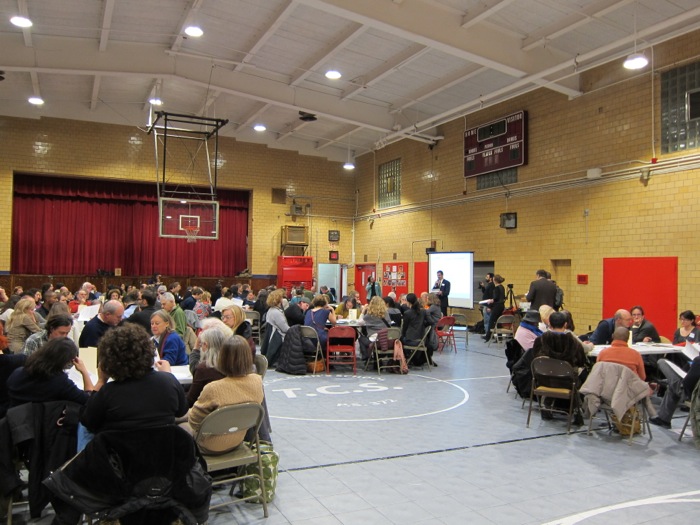Gowanus Locals Call for Rezoning to Preserve Area's Affordability, Vibrant Mix
A larger than anticipated crowd of over 200 people showed up to discuss their concerns and wishes and help plan the future of Gowanus development Monday night at The Children’s School on Carroll Street. The meeting was the first of a series of public planning forums called Bridging Gowanus convened by local politicians about the ongoing development…


A larger than anticipated crowd of over 200 people showed up to discuss their concerns and wishes and help plan the future of Gowanus development Monday night at The Children’s School on Carroll Street. The meeting was the first of a series of public planning forums called Bridging Gowanus convened by local politicians about the ongoing development of and cleanup plan for Gowanus. The Pratt Center for Community Development moderated and presented findings from previous invitation-only meetings held over the summer.
City Council Member Brad Lander remarked that with the EPA’s Record of Decision for the Gowanus Canal Superfund Site and the impending transition at City Hall, it’s an important moment for the community to come together and establish a shared vision for the infrastructure of the low-lying and industrially polluted Gowanus area before planning begins. The consensus of the crowd was that every effort should be made to preserve the area’s socioeconomic diversity and keep it affordable for the mixed uses (manufacturing, residential, commercial, artistic) that currently exist. A number of local artists in attendance expressed fears of gentrification and said they felt threatened by the diminishing affordability of studio space. In brief, locals called for a rezoning to preserve affordability and Gowanus’ eclectic identity as a community with vibrant street life and activity.
Other issues raised included the need for a permanent protection plan against coastal disasters; it was noted that the current recovery infrastructure is insufficient to handle even regular rain. The group also said another priority is more schools and suitable health care facilities to accommodate the area’s growing residential population. They would also like the canal to be opened up as a recreational public waterway.
A series of followup meetings will be held early in 2014. In the meantime, anyone interested in joining a working group can contact info@BridgingGowanus.org.
Gowanus Residents Meeting to Create Development Plan [Brownstoner]





The participants were talked at, as the planners made their presentation–being told what the community had consensus on before anyone of them got a chance to speak. Then they got to talk among themselves in table groups. At no time dis the organizers take any consensus of the participants–though they did collect table notes which they will sift through and self-select what the consensus may have been. I think they used the word “consensus-ing” yes I think that is what they do with all the notes that were taken, they do their consensus-ing quite apart from the any community open discussion.
This meeting was really interesting with heartfelt aims of keeping Gowanus vibrant for artists, business and residents and letting citizens try to plot a future course rather than politically-connected developers. But the elephant in the room was not mentioned. The 700 apartment, 12 story towers of the Lightstone development on Bond Street is going to subvert this entire process. Its a 4th Avenue type building that will exacerbate flooding issues, increase sewage overflow, block sunlight along the canal, impair streetlife, harm affordability (500 of the 700 units are “unaffordable”) etc. – and once its up, every developer will point to it and say “they got a building that size, we want it too.” So unless the local politicians who say they oppose the project actually do something to stop it, the whole Bridging Gowanus effort is for naught.
The Lightstone project is “Mixed-use” believe it or not. Included with the 700 apartments will be about 1200 sq ft of space for something like a yoga studio. That is acceptable mixed use under mixed-use zoning. There is no way under city law to compel developers to do any more than that.
So the mixed use zoning the planners were calling for would allow for many more developments like Lightstone. Thus, locking in a mixed use zoning would destroy the character of the area. If the goal is to lock in Manufacturing, than there is no need for a zoning change. A firm statement of support for the manufacturing zoning is all that would be need to allow business development to take off in the area–providing real jobs which is very one important thing need to make housing affordable.